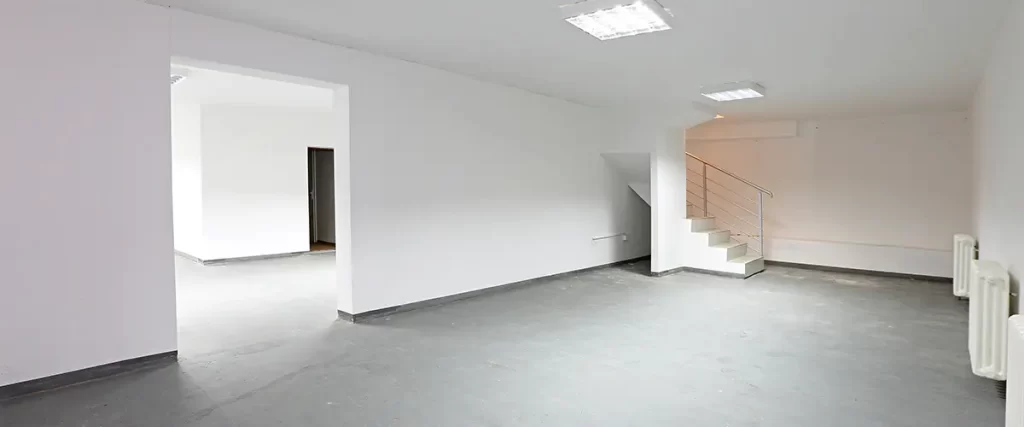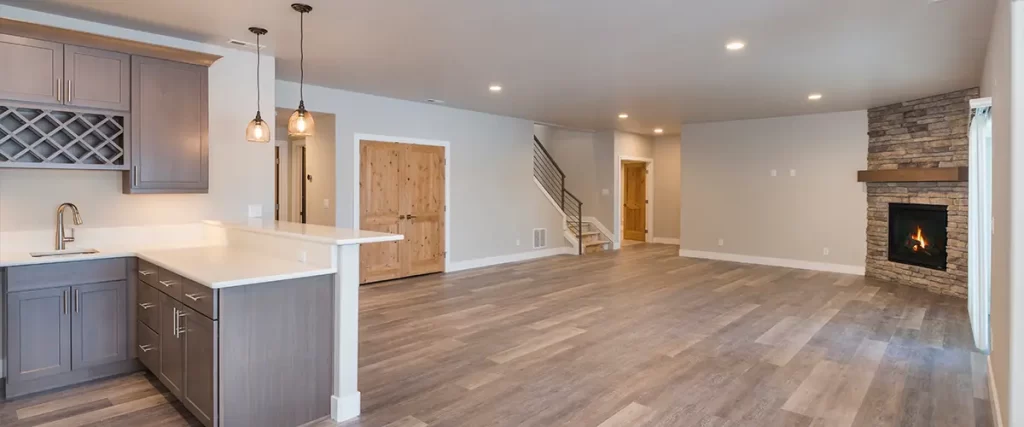When considering the foundation of your home, you might come across two main options: a crawl space or a basement. Both have their advantages and disadvantages depending on your needs and the specific conditions of your area.
Whether you’re looking to add extra storage, living space, or just curious about the difference, this guide will walk you through everything you need to know about crawl spaces and basements to help you make an informed decision.

What’s the Major Difference Between a Crawl Space and a Basement?
At its core, the major difference between a crawl space and a basement is the space itself. A crawl space is typically a small, unfinished area just beneath the bottom floor of a house, often only a few feet tall.
In contrast, a basement provides more room—sometimes even standing height—which can be finished into additional living space, extra storage, or a home gym.
Basements usually have concrete floors and foundation walls, while crawl spaces may have a concrete slab or dirt floor.
For homeowners in areas with wet climates or freezing temperatures, both foundations serve specific needs. For example, in areas prone to moisture, a crawl space may be beneficial for protecting the structural integrity of the house. On the other hand, basements can be an excellent option for those needing additional square footage for storage or living spaces.
How to Choose Between a Crawl Space and a Basement
When choosing between a crawl space vs basement, you’ll want to consider factors like your location, budget, and intended use. If you want extra storage space, a crawl space could be the right choice. If you’re dreaming of a craft room, home gym, or even an additional bedroom, a basement may be the better option for you.
It’s also important to think about the construction of your home. If your house is built on a slab foundation, installing a crawl space or basement may require extra labor, excavation, or major changes. For homes built on a foundation with room underneath, adding a basement or crawl space might be more straightforward.
Crawl Space Advantages
- Easy Access: Crawl spaces are typically built to allow easy access to plumbing, electrical, and HVAC systems beneath the home.
- Less Maintenance: Generally, crawl spaces require less maintenance than a basement and can be more cost-effective to build.
- Storage: Crawl spaces provide some storage space but can’t compare to the extra living space or storage a basement can offer.
Basement Advantages
- Extra Living Space: A basement can be transformed into additional living space, such as a finished basement with bedrooms, a craft room, or even a man cave.
- More Storage: A basement offers significantly more storage than a crawl space, making it ideal for storing large items, seasonal decorations, or creating extra storage rooms.
- Home Value: Adding a basement to your house can increase your home’s square footage and overall market value.

Environmental Considerations and Energy Efficiency
Beyond space and cost, the environmental impact and energy efficiency of crawl spaces and basements are crucial factors.
Unsealed crawl spaces are a major source of moisture infiltration, which can lead to problems like mold, mildew, and wood rot.
Encapsulating a crawl space with a vapor barrier and ensuring proper ventilation can greatly improve air quality and protect the structural integrity of a home. In humid climates, dehumidifiers may also be necessary to maintain optimal moisture levels in crawl spaces.
Basements, when properly insulated, can significantly enhance energy efficiency by maintaining a consistent temperature throughout the home.
Below-grade basements naturally stay cooler in summer and warmer in winter, reducing the need for excessive heating and cooling. However, poorly insulated basements can result in heat loss and higher energy bills, making proper insulation critical.
Basements are also more prone to radon gas accumulation due to their proximity to the ground. Radon testing and mitigation systems are essential in areas with high radon levels to ensure safety. Crawl spaces are not exempt from this risk and should also be tested for radon.
Crawl spaces often house HVAC ducting, and if they are not properly sealed, the HVAC system can lose efficiency. On the other hand, basements frequently contain the HVAC system itself, and conditioning the basement can enhance the overall efficiency of the system.
Properly managing these spaces is key to maintaining a functional and efficient HVAC setup.
Resale Value and Regional Preferences
The decision between a crawl space and a basement can also impact your home’s resale value, and regional preferences play a significant role.
A finished basement can significantly increase a home’s market value in areas where basements are common. In regions with crawl spaces, buyers may prioritize proper encapsulation and moisture control over having a full basement.
It’s essential to consider local market trends and determine which features are most appealing to potential buyers.
Regional preferences also play a major role in deciding between basements and crawl spaces. In colder climates, basements are often preferred for frost protection and as additional living space during harsh winters.
Conversely, in warmer, humid climates, crawl spaces are favored for their ventilation benefits and ability to prevent moisture buildup. In flood-prone areas, raised crawl spaces can help reduce the risk of water damage, while in mountainous regions, basements can be designed to align with sloped topography, offering both functionality and practicality.
Local building codes and regulations are another key factor to consider. These rules may affect the feasibility and cost of building a basement or crawl space, so understanding the requirements in your area is crucial.
For example, foundation depth requirements for frost protection can vary significantly by region, making it important to align your construction plans with local standards.
| Feature | Crawl Space | Basement |
| Space/Size | Limited, typically few feet tall | Extensive, often full standing height |
| Usability | Storage, access to utilities | Living space, storage, recreation |
| Construction Cost | Lower | Higher |
| Maintenance | Lower, requires moisture control | Higher, requires waterproofing, potential radon mitigation |
| Moisture Control | Requires vapor barrier, ventilation | Requires waterproofing, sump pump in wet areas |
| Energy Efficiency | Can improve if encapsulated; unsealed can reduce efficiency | Can improve if insulated; uninsulated can reduce efficiency |
| Resale Value | Moderate, dependent on proper maintenance | Higher, especially if finished |
| Access to Utilities | Easy access | Possible, depends on layout |
| Climate Suitability | Warmer, humid climates (with proper encapsulation) | Colder climates, flood-prone areas (raised) |
| Potential Issues | Moisture, mold, pests, radon | Flooding, leaks, radon, structural issues |
| Living Space Potential | None | High |
| Building Codes | Generally less stringent | Can be more stringent |
Retrofitting and Conversion Considerations
Many homeowners consider converting an existing crawl space to a basement, or vice versa. This section explores the complexities and factors involved in such projects.
Crawl Space to Basement Conversion:
Feasibility: This is a major undertaking that requires significant excavation, structural reinforcement, and often, raising the existing structure. It’s only feasible if the existing foundation and soil conditions allow it.
Cost: Conversion is typically very expensive, as it involves extensive labor, materials, and potential engineering assessments.
Permitting: Local building codes and permits are essential, and the project must meet stringent requirements to ensure structural integrity and safety.
Drainage: Proper drainage is critical to prevent water infiltration. This may involve installing a sump pump, perimeter drains, and waterproofing measures.
Benefits: The primary benefit is the significant increase in usable living space and potential resale value.
Basement to Crawl Space Conversion:
- Reasons: This is less common but might be considered in areas prone to flooding or if a homeowner wants to reduce maintenance costs.
- Process: It involves raising the foundation, filling the existing basement area, and constructing a crawl space.
- Challenges: Ensuring proper ventilation and moisture control in the new crawl space is crucial.
- Cost: While less expensive than converting a crawl space to a basement, it still involves significant structural work.
Retrofitting Existing Spaces:
- Encapsulation: For existing crawl spaces, encapsulation is a popular retrofit that involves sealing the space with a vapor barrier, insulating the walls, and installing a dehumidifier.
- Finishing: For existing basements, finishing the space can add significant value and usability. This includes framing, insulation, drywall, flooring, and electrical work.
- Waterproofing: Older basements may require waterproofing upgrades to prevent leaks and moisture problems.

Insurance and Homeowner Responsibilities
Understanding the insurance implications and responsibilities associated with crawl spaces and basements is crucial for homeowners.
Insurance Coverage:
- Flood Insurance: Standard homeowner’s insurance typically does not cover flood damage. If your basement is prone to flooding, you’ll need separate flood insurance.
- Water Damage: Coverage for water damage from leaks or seepage may vary depending on the cause and your policy.
- Mold and Mildew: Some policies may cover mold remediation if it results from a covered peril, such as a burst pipe.
- Crawl Space Damage: Insurance may cover damage to a crawl space from covered perils, but it’s essential to understand the specific terms of your policy.
Homeowner Responsibilities:
- Regular Inspections: Regularly inspect your crawl space or basement for signs of moisture, leaks, or structural issues.
- Maintenance: Perform routine maintenance, such as cleaning gutters, ensuring proper drainage, and maintaining sump pumps.
- Ventilation: Ensure adequate ventilation in crawl spaces to prevent moisture buildup.
- Radon Testing: If you have a basement, consider radon testing and mitigation if necessary.
- Documentation: Keep records of any maintenance, repairs, or inspections performed on your foundation.
- Disclosures: When selling your home, disclose any known issues with the crawl space or basement to potential buyers.
Frequently Asked Questions
What is the difference between a crawl space and a basement?
The major difference lies in the amount of space and how it’s used. A crawl space is usually a small, unfinished area underneath the house, while a basement provides significantly more room, which can be finished into additional living space, like bedrooms, or used for extra storage space.
A basement typically has concrete floors and foundation walls, whereas a crawl space might have a concrete slab or a dirt floor.
Which is better for my home, a crawl space or a basement?
It depends on your needs and the climate where you live. If you need extra storage space and easy access to plumbing, electrical, or HVAC systems, a crawl space might be an excellent option. However, if you’re looking for additional living space or want a finished basement for a home gym or man cave, then a basement is likely a better choice.
Can I add living space to a crawl space?
No, a crawl space typically cannot be finished into living space due to its low ceiling height. However, you can use a crawl space for storage or access to plumbing and HVAC ducts. If you’re looking for additional living space like bedrooms or a craft room, you would need to consider a basement.
Are crawl spaces better for areas prone to moisture?
Yes, crawl spaces are often a good solution in wet climates because they allow air circulation underneath the house. To protect against moisture, a crawl space should be equipped with a vapor barrier, which can help reduce moisture build-up and prevent water damage.
Is a crawl space or basement more affordable to build?
Typically, crawl spaces are less expensive to build than basements. They require less excavation and less concrete, meaning they’re usually quicker and cheaper to construct. On the other hand, basements can be more expensive due to the need for extensive excavation, foundation walls, and concrete.
Can I use a basement for storage?
Yes, basements are excellent for additional storage space. Many homeowners use basements to store seasonal items, furniture, or even create separate rooms for storage like a pantry, laundry area, or storage closet. With a basement, you have more flexibility to store items than you would in a crawl space.
Will a crawl space affect the structural integrity of my home?
A crawl space should not negatively affect the structural integrity of your house if properly maintained. It allows air to circulate under the house, preventing moisture buildup and mold growth. However, poor drainage or lack of insulation can lead to issues like water damage or uneven settling over time.
What are the benefits of having a basement in Reno?
In Reno, where the weather can vary significantly, having a basement provides extra living space for families and more storage options. Plus, during the summer heat, a basement can remain cooler and more comfortable than the rest of the house, which can be beneficial in areas with fluctuating temperatures.

Conclusion
When deciding between a crawl space and a basement for your home in Reno, it’s important to consider the climate, your home’s foundation, and how you plan to use the space. Whether you’re looking for storage, additional living space, or easy access to your HVAC systems, both options offer distinct advantages.
If you’re thinking about improving your home’s foundation or adding a crawl space or basement, reach out to a trusted professional who understands the ins and outs of the local climate. Contact us at (919) 308-1515, and we’d be happy to help guide you through the process.
